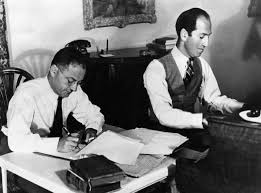TEA FOR TWO
Two Jewish Russian immigrant brothers gave the world some of the most endearing songs ever written. They revolutionized musical theater with an operetta exploring life as black people in America. One brother left the world too early. George and Ira Gershwin wrote songs with clever lyrics and heartfelt sentiment. The Gershwins were some of the best songwriters ever to pen a tune.
George was born Jacob Gershwine in 1898 ; Ira was born Israel Gershwine two years earlier. (The family dropped the e in Gershwine when the brothers became well known.) George left school at 15 to become a Tin Pan Alley song plugger. He made rolls for player pianos. This netted him $15 per week. Shy, bookish Ira had made friends with Yip Harburg who wrote songs himself. Ira wrote lyrics for a friend's musical in 1921. In 1919 George wrote the song Swanee - popularized by the era's biggest entertainer - Al Jolson. In 1924 George wrote Rhapsody In Blue, a piano composition that planted jazz and classical music.
The brothers collaborated on Lady Be Good - their first musical. In 1931 they wrote Of Thee I Sing, which became the first musical to win a Pulitzer Prize for best drama. The brothers then set about turning the Dubose Heyward novel Porgy - a tale of a black man lynched by an angry mob, into an operetta. Ahead of its time musically and politically, Porgy & Bess was hard to classify and therefore poorly reviewed. The brothers moved to Hollywood and wrote songs for the movies.
In 1937 George began experiencing headaches. He suffered mood swings and difficulty playing piano. He fell into a coma and was rushed to a hospital. After surgery to remove a brain tumor, George Gershwin died at age 38 on July 11, 1937. Ira took a three year break from music after George's death. He continued to write songs until the 1950s. Ira died August 17, 1983. The Gershwin's left a legacy of songs still known and performed 100 years after they were written, a testament to their fascinatin' rhythm.
SOURCES :
George Gershwin. Wikipedia.
Ira Gershwin. Wikipedia




Comments
Post a Comment